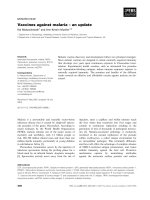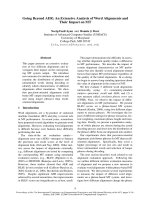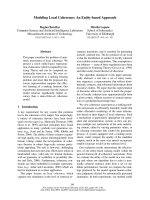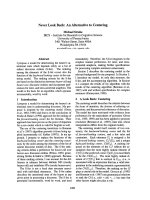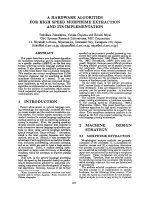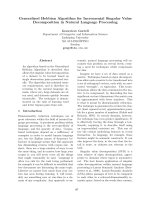Báo cáo khoa học: "Graph Branch Algorithm: An Optimum Tree Search Method for Scored Dependency Graph with Arc Co-occurrence Constraints" potx
Bạn đang xem bản rút gọn của tài liệu. Xem và tải ngay bản đầy đủ của tài liệu tại đây (222.99 KB, 8 trang )
Proceedings of the COLING/ACL 2006 Main Conference Poster Sessions, pages 361–368,
Sydney, July 2006.
c
2006 Association for Computational Linguistics
Graph Branch Algorithm: An Optimum Tree Search Method for Scored
Dependency Graph with Arc Co-occurrence Constraints
Hideki Hirakawa
Toshiba R&D Center
1 Komukai Toshiba-cho, Saiwai-ku,
Kawasaki 210, JAPAN
Abstract
Various kinds of scored dependency
graphs are proposed as packed shared data
structures in combination with optimum
dependency tree search algorithms. This
paper classifies the scored dependency
graphs and discusses the specific features
of the “Dependency Forest” (DF) which is
the packed shared data structure adopted
in the “Preference Dependency Grammar”
(PDG), and proposes the “Graph Branch
Algorithm” for computing the optimum
dependency tree from a DF. This paper
also reports the experiment showing the
computational amount and behavior of the
graph branch algorithm.
1 Introduction
The dependency graph (DG) is a packed shared
data structure which consists of the nodes corre-
sponding to the words in a sentence and the arcs
showing dependency relations between the nodes.
The scored DG has preference scores attached to
the arcs and is widely used as a basis of the opti-
mum tree search method. For example, the scored
DG is used in Japanese Kakari-uke analysis
1
to represent all possible kakari-uke(dependency)
trees(Ozeki, 1994),(Hirakawa, 2001). (McDon-
ald et al., 2005) proposed a dependency analysis
method using a scored DG and some maximum
spanning tree search algorithms. In this method,
scores on arcs are computed from a set of features
obtained from the dependency trees based on the
1
Kakari-uke relation, widely adopted in Japanese sen-
tence analysis, is projective dependency relation with a con-
straint such that the dependent word is located at the left-hand
side of its governor word.
optimum parameters for scoring dependency arcs
obtained by the discriminative learning method.
There are various kinds of dependency analy-
sis methods based on the scored DGs. This pa-
per classifies these methods based on the types
of the DGs and the basic well-formed constraints
and explains the features of the DF adopted in
PDG(Hirakawa, 2006). This paper proposes the
graph branch algorithm which searches the opti-
mum dependency tree from a DF based on the
branch and bound (B&B) method(Ibaraki, 1978)
and reports the experiment showing the computa-
tional amount and behavior of the graph branch
algorithm. As shown below, the combination of
the DF and the graph branch algorithm enables the
treatment of non-projective dependency analysis
and optimum solution search satisfying the single
valence occupation constraint, which are out of the
scope of most of the DP(dynamic programming)-
based parsing methods.
2 Optimum Tree Search in a Scored DG
2.1 Basic Framework
Figure 1 shows the basic framework of the opti-
mum dependency tree search in a scored DG. In
general, nodes in a DG correspond to words in
the sentence and the arcs show some kind of de-
pendency relations between nodes. Each arc has
Scored Dependency
Graph
Dependency
Tree
Set of Scored Well-
formed Dependency
Trees
Well-formed
dependency tree
constraint
Optimum Tree
Search
Algorithm
Well-formed Dependency
Tree with the highest score
s
1
s
2
s
3
s
4
s
5
(score=s
1
+s
2
+s
3
+s
4
+s
5
)
Scored Dependency
Graph
Dependency
Tree
Set of Scored Well-
formed Dependency
Trees
Well-formed
dependency tree
constraint
Optimum Tree
Search
Algorithm
Well-formed Dependency
Tree with the highest score
s
1
s
2
s
3
s
4
s
5
(score=s
1
+s
2
+s
3
+s
4
+s
5
)
Figure 1: The optimum tree search in a scored DG
361
a preference score representing plausibility of the
relation. The well-formed dependency tree con-
straint is a set of well-formed constraints which
should be satisfied by all dependency trees repre-
senting sentence interpretations. A DG and a well-
formed dependency tree constraint prescribe a set
of well-formed dependency trees. The score of a
dependency tree is the sum total of arc scores. The
optimum tree is a dependency tree with the highest
score in the set of dependency trees.
2.2 Dependency Graph
DGs are classified into some classes based on the
types of nodes and arcs. This paper assumes three
types of nodes, i.e. word-type, WPP-type
2
and
concept-type
3
. The types of DGs are called a word
DG, a WPP DG and a concept DG, respectively.
DGs are also classified into non-labeled and la-
beled DGs. There are some types of arc labels
such as syntactic label (ex. “subject”,“object”)
and semantic label (ex. “agent”,“target”). Var-
ious types of DGs are used in existing sys-
tems according to these classifications, such as
non-label word DG(Lee and Choi, 1997; Eisner,
1996; McDonald et al., 2005)
4
, syntactic-label
word DG (Maruyama, 1990), semantic-label word
DG(Hirakawa, 2001), non-label WPP DG(Ozeki,
1994; Katoh and Ehara, 1989), syntactic-label
WPP DG(Wang and Harper, 2004), semantic-label
concept DG(Harada and Mizuno, 2001).
2.3 Well-formedness Constraints and Graph
Search Algorithms
There can be a variety of well-formedness con-
straints from very basic and language-independent
constraints to specific and language-dependent
constraints. This paper focuses on the following
four basic and language-independent constraints
which may be embedded in data structure and/or
the optimum tree search algorithm.
(C1) Coverage constraint: Every input word has
a corresponding node in the tree
(C2) Single role constraint(SRC): No two nodes
in a dependency tree occupy the same input
position
2
WPP is a pair of a word and a part of speech (POS). The
word “time” has WPPs such as “time/n” and “time/v”.
3
One WPP (ex. “time/n”) can be categorized into one or
more concepts semantically (ex. “time/n/period time” and
“time/n/clock time”).
4
This does not mean that these algorithms can not handle
labeled DGs.
(C3) Projectivity constraint(PJC): No arc crosses
another arc
5
(C4) Single valence occupation constraint(SVOC):
No two arcs in a tree occupy the same valence
of a predicate
(C1) and (C2), collectively referred to as “cover-
ing constraint”, are basic constraints adopted by
almost all dependency parsers. (C3) is adopted
by the majority of dependency parsers which are
called projective dependency parsers. A projective
dependency parser fails to analyze non-projective
sentences. (C4) is a basic constraint for valency
but is not adopted by the majority of dependency
parsers.
Graph search algorithms, such as the Chu-
Liu-Edmonds maximum spanning tree algorithm
(Chu and Liu, 1965; Edmonds, 1967), algorithms
based on the dynamic programming (DP) princi-
ple (Ozeki, 1994; Eisner, 1996) and the algorithm
based on the B&B method (Hirakawa, 2001), are
used for the optimum tree search in scored DGs.
The applicability of these algorithms is closely re-
lated to the types of DGs and/or well-formedness
constraints. The Chu-Liu-Edmonds algorithm is
very fast ( for sentence length ), but it
works correctly only on word DGs. DP-based al-
gorithms can satisfy (C1)-(C3) and run efficiently,
but seems not to satisfy (C4) as shown in 2.4.
(C2)-(C4) can be described as a set of co-
occurrence constraints between two arcs in a DG.
As described in Section 2.6, the DF can represent
(C2)-(C4) and more precise constraints because it
can handle co-occurrence constraints between two
arbitrary arcs in a DG. The graph branch algorithm
described in Section 3 can find the optimum tree
from the DF.
2.4 SVOC and DP
(Ozeki and Zhang, 1999) proposed the minimum
cost partitioning method (MCPM) which is a parti-
tioning computation based on the recurrence equa-
tion where the cost of joining two partitions is
the cost of these partitions plus the cost of com-
bining these partitions. MCPM is a generaliza-
tion of (Ozeki, 1994) and (Katoh and Ehara, 1989)
which compute the optimum dependency tree in a
scored DG. MCPM is also a generalization of the
probabilistic CKY algorithm and the Viterbi algo-
5
Another condition for projectivity, i.e. “no arc covers top
node” is equivalent to the crossing arc constraint if special
root node , which is a governor of top node, is introduced at
the top (or end) of a sentence.
362
agent1,15
Isha-mo
(doctor)
Wakaranai
(not_know)
Byouki-no
(sickness)
Kanja
(patient)
target2,10
agent3,5
target4,7
in-state7,10
agent5,15
target6,5
OS
1
[15]: (agent1,15)
OS
3
[22]: (agent1,15) + (target4,7)
OS
2
[10]: (in-state7,10)
OS
4
[25]: (agent5,15) + (in-state7,10)NOS
1
[10]: (target2,10)
NOS
2
[20]: (target4,10) + (in-state7,10)OS
1
[15]: (agent1,15)
OS
4
[25]: (agent5,15) + (in-state7,10)
Well-formed optimum solutions for covering whole phrase
agent1,15
Isha-mo
(doctor)
Wakaranai
(not_know)
Byouki-no
(sickness)
Kanja
(patient)
target2,10
agent3,5
target4,7
in-state7,10
agent5,15
target6,5
OS
1
[15]: (agent1,15)
OS
3
[22]: (agent1,15) + (target4,7)
OS
2
[10]: (in-state7,10)
OS
4
[25]: (agent5,15) + (in-state7,10)NOS
1
[10]: (target2,10)
NOS
2
[20]: (target4,10) + (in-state7,10)OS
1
[15]: (agent1,15)
OS
4
[25]: (agent5,15) + (in-state7,10)
Well-formed optimum solutions for covering whole phrase
Figure 2: Optimum tree search satisfying SVOC
rithm
6
. The minimum cost partition of the whole
sentence is calculated very efficiently by the DP
principle. The optimum partitioning obtained by
MCPM constitutes a tree covering the whole sen-
tence satisfying the SRC and PJC. However, it is
not assured that the SVOC is satisfied by MCPM.
Figure 2 shows a DG for the Japanese phrase
“Isha-mo Wakaranai Byouki-no Kanja” encom-
passing dependency trees corresponding to “a pa-
tient suffering from a disease that the doctor
doesn’t know”, “a sick patient who does not know
the doctor”, and so on. - represent the op-
timum solutions for the phrases specified by their
brackets computed based on MCPM. For exam-
ple, gives an optimum tree with a score of
(consisting of and ) for the phrase
“Isha-mo Wakaranai Byouki-no”. The optimum
solution for the whole phrase is either
or due to MCPM. The former has the
highest score but does not satisfy
the SVOC because it has and si-
multaneously. The optimum solutions satisfying
the SVOC are and
shown at the bottom of Figure 2. and
are not optimum solutions for their word
coverages. This shows that it is not assured that
MCPM will obtain the optimum solution satisfy-
ing the SVOC.
On the contrary, it is assured that the graph
branch algorithm computes the optimum solu-
tion(s) satisfying the SVOC because it com-
putes the optimum solution(s) satisfying any co-
occurrence constraints in the constraint matrix. It
is an open problem whether an algorithm based
on the DP framework exists which can handle the
SVOC and arbitrary arc co-occurrence constraints.
6
Specifically, MTCM corresponds to probabilistic CKY
and the Viterbi algorithm because it computes both the opti-
mum tree score and its structure.
Constraint
Matrix
Dependency
Graph
Meaning of Arc Name
sub : subject
obj : object
npp : noun-preposition
vpp : verb-preposition
pre : preposition
nc : noun compound
det : determiner
rt : root
npp19
det14
pre15
vpp20
vpp18
sub24
sub23
obj4
nc2
obj16
0,time/n 1,fly/v
0,time/v 1,fly/n
2,like/p
2,like/v
3,an/det 4,arrow/n
root
rt29
rt32
rt31
Constraint
Matrix
Dependency
Graph
Meaning of Arc Name
sub : subject
obj : object
npp : noun-preposition
vpp : verb-preposition
pre : preposition
nc : noun compound
det : determiner
rt : root
npp19
det14
pre15
vpp20
vpp18
sub24
sub23
obj4
nc2
obj16
0,time/n 1,fly/v
0,time/v 1,fly/n
2,like/p
2,like/v
3,an/det 4,arrow/n
root
rt29
rt32
rt31
Meaning of Arc Name
sub : subject
obj : object
npp : noun-preposition
vpp : verb-preposition
pre : preposition
nc : noun compound
det : determiner
rt : root
npp19
det14
pre15
vpp20
vpp18
sub24
sub23
obj4
nc2
obj16
0,time/n 1,fly/v
0,time/v 1,fly/n
2,like/p
2,like/v
3,an/det 4,arrow/n
root
rt29
rt32
rt31
npp19
det14
pre15
vpp20
vpp18
sub24
sub23
obj4
nc2
obj16
0,time/n 1,fly/v
0,time/v 1,fly/n
2,like/p
2,like/v
3,an/det 4,arrow/n
root
rt29
rt32
rt31
npp19
det14
pre15
vpp20
vpp18
sub24
sub23
obj4
nc2
obj16
0,time/n 1,fly/v
0,time/v 1,fly/n
2,like/p
2,like/v
3,an/det 4,arrow/n
root
rt29
rt32
rt31
Figure 3: Scored dependency forest
2.5 Semantic Dependency Graph (SDG)
The SDG is a semantic-label word DG designed
for Japanese sentence analysis. The optimum tree
search algorithm searches for the optimum tree
satisfying the well-formed constraints (C1)-(C4)
in a SDG(Hirakawa, 2001). This method is lack-
ing in terms of generality in that it cannot handle
backward dependency and multiple WPP because
it depends on some linguistic features peculiar to
Japanese. Therefore, this method is inherently in-
applicable to languages like English that require
backward dependency and multiple POS analysis.
The DF described below can be seen as the ex-
tension of the SDG. Since the DF has none of the
language-dependent premises that the SDG has, it
is applicable to English and other languages.
2.6 Dependency Forest (DF)
The DF is a packed shared data structure en-
compassing all possible dependency trees for a
sentence adopted in PDG. The DF consists of a
dependency graph (DG) and a constraint matrix
(CM). Figure 3 shows a DF for the example sen-
tence “Time flies like an arrow.” The DG consists
of nodes and directed arcs. A node represents a
WPP and an arc shows the dependency relation
between nodes. An arc has its ID and preference
score. CM is a matrix whose rows and columns
are a set of arcs in DG and prescribes the co-
occurrence constraint between arcs. Only when
CM(i,j) is ○, and are co-occurrable in
one dependency tree.
The DF is generated by using a phrase structure
parser in PDG. PDG grammar rule is an extended
CFG rule, which defines the mapping between
a sequence of constituents (the body of a CFG
rule) and a set of arcs (a partial dependency tree).
363
The generated CM assures that the parse trees in
the parse forest and the dependency trees in the
DF have mutual correspondence(Hirakawa, 2006).
CM can represent (C2)-(C4) in 2.3 and more pre-
cise constraints. For example, PDG can generate
a DF encompassing non-projective dependency
trees by introducing the grammar rules defining
non-projective constructions. This is called the
controlled non-projectivity in this paper. Treat-
ment of non-projectivity as described in (Kanahe
et al., 1998; Nivre and Nilsson, 2005) is an impor-
tant topic out of the scope of this paper.
3 The Optimum Tree Search in DF
This section shows the graph branch algorithm
based on the B&B principle, which searches for
the optimum well-formed tree in a DF by apply-
ing problem expansions called graph branching.
3.1 Outline of B&B Method
The B&B method(Ibaraki, 1978) is a principle
for solving computationally hard problems such
as NP-complete problems. The basic strategy is
that the original problem is decomposed into eas-
ier partial-problems (branching) and the original
problem is solved by solving them. Pruning called
a bound operation is applied if it turns out that the
optimum solution to a partial-problem is inferior
to the solution obtained from some other partial-
problem (dominance test)
7
, or if it turns out that
a partial-problem gives no optimum solutions to
the original problem (maximum value test). Usu-
ally, the B&B algorithm is constructed to mini-
mize the value of the solution. The graph branch
algorithm in this paper is constructed to maximize
the score of the solution because the best solution
is the maximum tree in the DF.
3.2 Graph Branch Algorithm
The graph branch algorithm is obtained by defin-
ing the components of the original B&B skeleton
algorithm, i.e. the partial-problem, the feasible so-
lution, the lower bound value, the upper bound
value, the branch operation, and so on(Ibaraki,
1978). Figure 4 shows the graph branch algorithm
which has been extended from the original B&B
skeleton algorithm to search for all the optimum
trees in a DF. The following sections explain the
B&B components of the graph branch algorithm.
7
The dominance test is not used in the graph branch algo-
rithm.
Figure 4: Graph branch algorithm
(1) Partial-problem
Partial-problem in the graph branch algo-
rithm is a problem searching for all the well-
formed optimum trees in a DF consisting of
the dependency graph and constraint matrix
. consists of the following elements.
(a) Dependency graph
(b) Constraint matrix
(c) Feasible solution value
(d) Upper bound value
(e) Inconsistent arc pair list
The constraint matrix is common to all partial-
problems, so one is shared by all partial-
problems. is represented by “ ” which
shows a set of arcs to be removed from the whole
dependency graph . For example, “ ”
represents a partial dependency graph in
the case . is a list of
inconsistent arc pairs. An inconsistent arc pair
is an arc pair which does not satisfy some co-
occurrence constraint.
364
(2) Algorithm for Obtaining Feasible Solution
and Lower Bound Value
In the graph branch algorithm, a well-formed
dependency tree in the dependency graph of
the partial-problem is assigned as the feasible
solution of
8
. The score of the feasible solu-
tion is assigned as the lower bound value .
The function for computing these values is
called a feasible solution/lower bound value func-
tion. The details are not shown due to space lim-
itations, but is realized by the backtrack-
based depth-first search algorithm with the opti-
mization based on the arc scores. assures
that the obtained solution satisfies the covering
constraint and the arc co-occurrence constraint.
The incumbent value (the best score so far) is
replaced by the at in Figure 4 if needed.
(3) Algorithm for Obtaining Upper Bound
Given a set of arcs which is a subset of ,
if the set of dependent nodes
9
of arcs in satisfies
the covering constraint, the arc set is called the
well-covered arc set. The maximum well-covered
arc set is defined as a well-covered arc set with
the highest score. In general, the maximum well-
covered arc set does not satisfy the SRC and does
not form a tree. In the graph branch algorithm, the
score of the maximum well-covered arc set of a de-
pendency graph is assigned as the upper bound
value of the partial-problem . Upper bound
function calculates by scanning the arc
lists sorted by the surface position of the depen-
dent nodes of the arcs.
(4) Branch Operation
Figure 5 shows a branch operation called a
graph branch operation. Child partial-problems of
are constructed as follows:
(a) Search for an inconsistent arc pair
in the maximum well-covered arc set of the
DG of .
(b) Create child partial-problems , which
have new DGs and
respectively.
Since a solution to cannot have both and
simultaneously due to the co-occurrence con-
straint, the optimum solution of is obtained
from either/both or/and . The child partial-
8
A feasible solution may not be optimum but is a possible
interpretation of a sentence. Therefore, it can be used as an
approximate output when the search process is aborted.
9
The dependent node of an arc is the node located at the
source of the arc.
DG: Dependency graph
of parent problem
arc
j
arc
i
DG
j
: Dependency graph
for child problem P
j
arc
j
DG
i
: Dependency graph
for child problem P
i
arc
i
Remove arc
j
Remove arc
i
DG: Dependency graph
of parent problem
arc
j
arc
i
arc
j
arc
i
DG
j
: Dependency graph
for child problem P
j
arc
j
arc
j
DG
i
: Dependency graph
for child problem P
i
arc
i
arc
i
Remove arc
j
Remove arc
i
Figure 5: Graph branching
problem is easier than the parent partial-problem
because the size of the DG of the child partial-
problem is less than that of its parent.
In Figure 4, computes the list of incon-
sistent arc pairs (Inconsistent Arc Pair List)
for the maximum well-covered arc set of . Then
the graph branch function selects
one inconsistent arc pair from
for branch operation. The selection criteria for
affects the efficiency of the algorithm.
selects the inconsistent arc pair
containing the highest score arc in (Branch
Arc Candidates List). calculates
the upper bound value for a child partial-problem
by and sets it to the child partial-problem.
(5) Selection of Partial-problem
employs the best bound search
strategy, i.e. it selects the partial-problem which
has the maximum bound value among the active
partial-problems. It is known that the number of
partial-problems decomposed during computation
is minimized by this strategy in the case that no
dominance tests are applied (Ibaraki, 1978).
(6) Computing All Optimum Solutions
In order to obtain all optimum solutions, partial-
problems whose upper bound values are equal to
the score of the optimum solution(s) are expanded
at in Figure 4. In the case that at least one
inconsistent arc pair remains in a partial-problem
(i.e. ), graph branch is performed
based on the inconsistent arc pair. Otherwise,
the obtained optimum solution is checked if
one of the arcs in has an equal rival arc by
function. The equal ri-
val arc of arc is an arc whose position and score
are equal to those of arc . If an equal rival arc
of an arc in exists, a new partial-problem is
generated by removing the arc in . assures
that no partial-problem has an upper bound value
365
P
0
P
1
P
3
P
2
P
4
P
0
P
1
P
3
P
2
P
4
Figure 6: Search diagram
greater than or equal to the score of the optimum
solutions when the computation stopped.
4 Example of Optimum Tree Search
This section shows an example of the graph branch
algorithm execution using the DF in Fig.3.
4.1 Example of Graph Branch Algorithm
The search process of the B&B method can be
shown as a search diagram constructing a partial-
problem tree representing the parent-child relation
between the partial-problems. Figure 6 is a search
diagram for the example DF showing the search
process of the graph branch algorithm.
In this figure, box is a partial-problem with
its dependency graph , upper bound value
, feasible solution and lower bound value
and inconsistent arc pair list . Suffix of
indicates the generation order of partial-problems.
Updating of global variable (incumbent value)
and (set of incumbent solutions) is shown un-
der the box. The value of the left-hand side of the
arrow is updated to that of right-hand side of the
arrow during the partial-problem processing. De-
tails of the behavior of the algorithm in Figure 4
are described below.
In , , and are set to
, and respectively. The DG of is
that of the example DF. This is represented by
. sets the upper bound value
(=63) of to . In practice, this is calcu-
lated by obtaining the maximum well-covered arc
set of . In , selects
and is executed. The feasible so-
lution and its score are calculated to set
, ( in the
search diagram).
updates and to new values. Then,
computes the inconsistent arc pair
list from the
maximum well-covered arc set
and set it to .
compares the upper bound value and the fea-
sible solution value . In this case,
holds, so is assigned the value of .
The next step executes the
function. selects
the arc pair with the highest arc score and performs
the graph branch operation with the selected arc
pair. The following is a shown with the
arc names and arc scores.
Scores are shown in . The arc pair contain-
ing the highest arc score is and
containing . Here, is selected and
partial-problems and are
generated. is removed from and the new
two partial-problems are added to resulting in
. Then, based on the best bound
search strategy, is tried again.
updates and because obtained a
feasible solution better than that in obtained
by . and are terminated because they
have no feasible solution. generates a feasi-
ble solution but and are not updated. This
is because the obtained feasible solution is infe-
rior to the incumbent solution in . The optimum
solution(= ) is obtained by .
The computation from to is required to as-
sure that the feasible solution of is optimum.
5 Experiment
This section describes some experimental results
showing the computational amount of the graph
branch algorithm.
5.1 Environment and Performance Metric
An existing sentence analysis system
10
(called the
oracle system) is used as a generator of the test
corpus, the preference knowledge source and the
correct answers. Experiment data of 125,320 sen-
tences
11
extracted from English technical docu-
10
A real-world rule-based machine translation system with
a long development history
11
Sentences ending with a period and parsable by the ora-
cle system.
366
ments is divided into open data (8605 sentences)
and closed data (116,715 sentences). The prefer-
ence score source, i.e. the WPP frequencies and
the dependency relation frequencies are obtained
from the closed data. The basic PDG grammar
(907 extended CFG rules) is used for generating
the DFs for the open data.
The expanded problem number (EPN), a prin-
cipal computational amount factor of the B&B
method, is adopted as the base metric. The fol-
lowing three metrics are used in this experiment.
(a) EPN in total (EPN-T): The number of the ex-
panded problems which are generated in the
entire search process.
(b) EPN for the first optimum solution (EPN-F):
The number of the expanded problems when
the first optimum solution is obtained.
(c) EPN for the last optimum solution (EPN-L):
The number of the expanded problems when
the last optimum solution is obtained. At this
point, all optimum solutions are obtained.
Optimum solution number (OSN) for a problem,
i.e. the number of optimum dependency trees in
a given DF, gives the lower bound value for all
these metrics because one problem generates at
most one solution. The minimum value of OSN
is 1 because every DF has at least one dependency
tree. As the search process proceeds, the algorithm
finds the first optimum solution, then the last opti-
mum solution, and finally terminates the process
by confirming no better solution is left. There-
fore, the three metrics and OSN have the relation
OSN EPN-F EPN-L EPN-T. Average val-
ues for these are described as Ave:OSN, Ave:EPN-
F, Ave:EPN-L and Ave:EPN-T.
5.2 Experimental Results
An evaluation experiment for the open data is
performed using a prototype PDG system imple-
mented in Prolog. The sentences containing more
than 22 words are neglected due to the limita-
tion of Prolog system resources in the parsing pro-
cess. 4334 sentences out of the remaining 6882
test sentences are parsable. Unparsable sentences
(2584 sentences) are simply neglected in this ex-
periment. The arc precision ratio
12
of the oracle
12
Correct arc ratio with respect to arcs in the output depen-
dency trees (Hirakawa, 2005).
Figure 7: EPN-T, EPN-F EPN-F and OSN
system for 136 sentences in this sentence set is
97.2% with respect to human analysis results.
All optimum trees are computed by the graph
branch algorithm described in Section 3.2. Fig-
ure 7 shows averages of EPN-T, EPN-L, EPN-F
and OSN with respect to sentence length. Over-
all averages of EPN-T, EPN-L, EPN-F and OSN
for the test sentences are 3.0, 1.67, 1.43 and 1.15.
The result shows that the average number of prob-
lems required is relatively small. The gap between
Ave:EPN-T and Ave:EPN-L (3.0-1.67=1.33) is
much greater than the gap between Ave:EPN-L
and Ave:OSN(1.67-1.15=0.52). This means that
the major part of the computation is performed
only for checking if the obtained feasible solutions
are optimum or not.
According to (Hirakawa, 2001), the experiment
on the B&B-based algorithm for the SDG shows
the overall averages of AVE:EPN-T, AVE:EPN-
F are 2.91, 1.33 and the average CPU time is
305.8ms (on EWS). These values are close to
those in the experiment based on the graph branch
algorithm. Two experiments show a tendency for
the optimum solution to be obtained in the early
stage of the search process. The graph branch al-
gorithm is expected to obtain the comparable per-
formance with the SDG search algorithm.
(Hirakawa, 2001) introduced the improved up-
per bound function g’(P) into the B&B-based al-
gorithm for the SDG and found Ave:EPN-T is re-
duced from 2.91 to 1.82. The same technique
is introduced to the graph branch algorithm and
has obtained the reduction of the Ave:EPN-T from
3.00 to 2.68.
The tendency for the optimum solution to be
obtained in the early stage of the search process
suggests that limiting the number of problems to
expand is an effective pruning strategy. Figure
8 shows the ratios of the sentences obtaining the
whole problem expansion, the first optimum solu-
367
Figure 8: ARs for EPS-F, EPS-A, EPS-T
tion and the last optimum solution to whole sen-
tences with respect to the EPNs. This kind of ratio
is called an achievement ratio (AR) in this paper.
From Figure 8, the ARs for EPN-T, EPN-L, EPN-
F (plotted in solid lines) are 97.1%,99.6%,99.8%
respectively at the EPN 10. The dotted line shows
the AR for EPN-T of the improved algorithm us-
ing g’(P). The use of g’(P) increases the AR for
EPN-T from 97.1% to 99.1% at the EPN 10. How-
ever, the effect of g’(P) is quite small for EPN-
F and EPN-L. This result shows that the pruning
strategy based on the EPN is effective and g’(P)
works for the reduction of the problems generated
in the posterior part of the search processes.
6 Concluding Remarks
This paper has described the graph branch algo-
rithm for obtaining the optimum solution for a
DF used in PDG. The well-formedness depen-
dency tree constraints are represented by the con-
straint matrix of the DF, which has flexible and
precise description ability so that controlled non-
projectivity is available in PDG framework. The
graph branch algorithm assures the search for the
optimum trees with arbitrary arc co-occurrence
constraints, including the SVOC which has not
been treated in DP-based algorithms so far. The
experimental result shows the averages of EPN-
T, EPN-L and EPN-F for English test sentences
are 3.0, 1.67 and 1.43, respectively. The practi-
cal code implementation of the graph branch algo-
rithm and its performance evaluation are subjects
for future work.
References
Y. J. Chu and T. H. Liu. 1965. On the shortest arbores-
cence of a directed graph. Science Sinica, 14.
J. Edmonds. 1967. Optimum branchings. Journal
of Research of the National Bureau of Standards,
71B:233–240.
J. Eisner. 1996. Three new probabilistic models for de-
pendency parsing: An exploration. In Proceedings
of COLING’96, pages 340–345.
M. Harada and T. Mizuno. 2001. Japanese semantic
analysis system sage using edr (in japanese). Trans-
actions of JSAI, 16(1):85–93.
H. Hirakawa. 2001. Semantic dependency analysis
method for japanese based on optimum tree search
algorithm. In Proceedings of the PACLING2001.
H. Hirakawa. 2005. Evaluation measures for natural
language analyser based on preference dependency
grammar. In Proceedings of the PACLING2005.
H. Hirakawa. 2006. Preference dependency grammar
and its packed shared data structure ’dependency
forest’ (in japanese). To appear in Natural Lan-
guage Processing, 13(3).
T. Ibaraki. 1978. Branch-and-bounding procedure
and state-space representation of combinatorial opti-
mization problems. Information and Control, 36,1-
27.
S. Kanahe, A. Nasr, and O. Rambow. 1998.
Pseudo-projectivity: A polynomially parsable non-
projective dependency grammar. In COLING-
ACL’98, pages 646–52.
N. Katoh and T. Ehara. 1989. A fast algorithm for
dependency structure analysis (in japanese). In Pro-
ceedings of 39th Annual Convention of the Informa-
tion Processing Society.
S. Lee and K. S. Choi. 1997. Reestimation and best-
first parsing algorithm for probablistic dependency
grammars. In Proceedings of the Fifth Workshop on
Very Large Corpora, pages 41–55.
H. Maruyama. 1990. Constraint dependency grammar
and its weak generative capacity. Computer Soft-
ware.
R. McDonald, F. Pereira, K. Ribarov, and J. Hajic.
2005. Non-projective dependency parsing using
spanning tree algorithms. In Proceedings of HLT-
EMNLP, pages 523–530.
J. Nivre and J. Nilsson. 2005. Pseudo-projective de-
pendency parsing. In ACL-05, pages 99–106.
K. Ozeki and Y. Zhang. 1999. 最小コスト分割問題
としての係り受け解析. In Proceeding of the Work-
shop of The Fifth Annual Meeting of The Association
for Natural Language Processing, pages 9–14.
K. Ozeki. 1994. Dependency structure analysis as
combinatorial optimization. Information Sciences,
78(1-2):77–99.
W. Wang and M. P. Harper. 2004. A statistical con-
straint dependency grammar (cdg) parser. In Work-
shop on Incremental Parsing: Bringing Engineering
and Cognition Together (ACL), pages 42–49.
368


